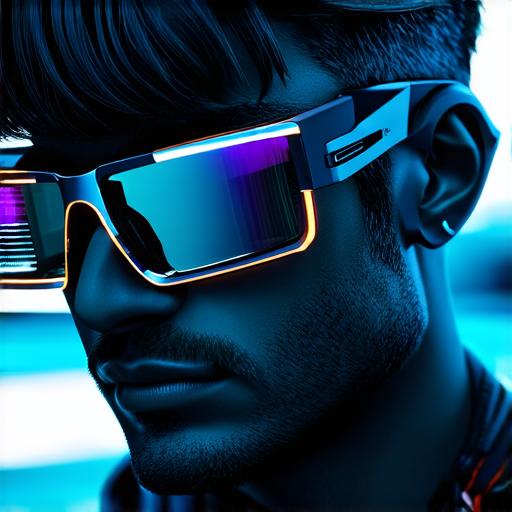Introduction
Augmented reality (AR) eyewear has been gaining popularity in recent years as a way to enhance the user experience. AR eyewear allows users to see virtual objects and information overlaid on top of their real-world environment, providing a more immersive and interactive experience. In this article, we will discuss the steps involved in constructing AR eyewear, including hardware and software considerations, design principles, and best practices for development.
Hardware Considerations
The first step in constructing AR eyewear is to choose the appropriate hardware. There are several types of AR eyewear available, including smart glasses, headsets, and wearable devices. Each type has its own advantages and disadvantages, and the choice will depend on the intended use case.
Smart Glasses: Smart glasses are a popular choice for AR developers because they are lightweight, comfortable to wear, and can be used in a variety of settings. However, smart glasses have limited processing power and may not be suitable for applications that require high-performance computing.

Headsets: Headsets provide a more immersive experience and are often used for gaming and entertainment applications. They typically have higher processing power than smart glasses and can support more advanced AR features. However, headsets can be bulky and uncomfortable to wear for extended periods of time.
Wearable Devices: Wearable devices such as watches and fitness trackers can also be used for AR applications. These devices are small and lightweight, making them ideal for use on the go. However, they may have limited display space and processing power.
Software Considerations
Once the hardware has been chosen, the next step is to consider the software requirements. AR eyewear requires specialized software that can interact with the hardware and overlay virtual objects onto the user’s real-world environment. There are several AR development platforms available, including Unity, ARKit, and Vuforia. Each platform has its own features and capabilities, so the choice will depend on the intended use case.
Unity is a popular choice for AR developers because it supports a wide range of platforms and has a large community of developers. It also has advanced graphics capabilities and support for 3D modeling.
ARKit is Apple’s AR development platform, and it is designed specifically for iOS devices. It provides easy integration with Apple’s ecosystem and has advanced tracking capabilities.
Vuforia is an open-source AR development platform that supports a wide range of platforms and has advanced object recognition capabilities.
Design Principles
When designing AR eyewear, there are several principles to keep in mind. First, the design should be comfortable to wear and should not interfere with the user’s natural vision. The display should also be clear and easy to read, even in low-light conditions.
Another important consideration is the placement of virtual objects in the real-world environment. AR eyewear should provide a seamless integration between the real world and the virtual objects, making it easy for the user to interact with them.
Best Practices for Development
To ensure successful development of AR eyewear, there are several best practices that should be followed. First, it is important to conduct thorough testing to identify any issues or bugs in the software. This includes testing on different hardware platforms and in a variety of real-world environments.
Another important practice is to optimize the software for performance, especially when dealing with high-performance computing requirements. This includes minimizing the use of resources such as CPU, GPU, and memory.
It is also important to consider the user experience when developing AR eyewear. This includes providing intuitive controls and easy-to-use interfaces that allow users to interact with virtual objects in a natural way.
Real-Life Examples
There are many real-life examples of successful AR eyewear applications. One such example is Snapchat’s AR filters, which have become incredibly popular among younger generations. The filters overlay virtual objects onto the user’s real-world environment, allowing them to add creative effects to their photos and videos.
Another example is IKEA’s AR app, which allows users to visualize how furniture would look in their home before making a purchase. The app uses AR technology to place virtual furniture in the user’s real-world environment, providing a more realistic preview of the product.
FAQs
1. What types of hardware can be used for AR eyewear?
Smart glasses, headsets, and wearable devices are commonly used for AR eyewear applications. The choice will depend on the intended use case.
2. What software platforms are available for AR development?
There are several AR development platforms available, including Unity, ARKit, and Vuforia. Each platform has its own features and capabilities.
3. What design principles should be followed when developing AR eyewear?
The design should be comfortable to wear and should not interfere with the user’s natural vision. The display should also be clear and easy to read, even in low-light conditions. Virtual objects should be placed seamlessly in the real-world environment, making it easy for the user to interact with them.
4. What are some best practices for developing AR eyewear?
Conduct thorough testing to identify any issues or bugs in the software. Optimize the software for performance by minimizing resource usage. Consider the user experience and provide intuitive controls and easy-to-use interfaces.
5. Are there any real-life examples of successful AR eyewear applications?
Yes, there are many real-life examples of successful AR eyewear applications, including Snapchat’s AR filters and IKEA’s AR app.
Summary
Augmented reality eyewear is a rapidly growing field with limitless potential for innovation. By following the hardware and software considerations outlined in this article, along with the design principles and best practices for development, AR developers can create immersive and interactive experiences that enhance the user’s real-world environment. With the right tools and techniques, AR eyewear has the potential to revolutionize a wide range of industries, from gaming and entertainment
